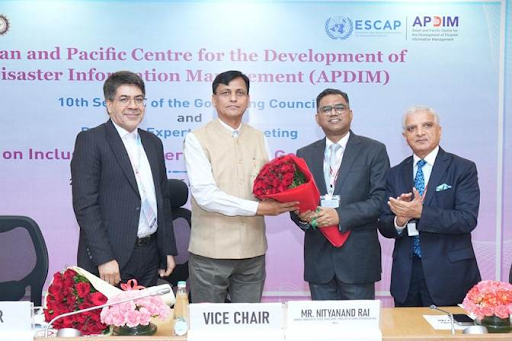Description

Disclaimer: Copyright infringement not intended.
Context: The Group of Seven (G7) industrialised nations have committed to promoting concrete infrastructure initiatives such as the India-Middle East-Europe Economic Corridor (IMEC) in the G7 Summit Communique issued at the end of the three-day G7 Summit.
Details
India-Middle East-Europe Economic Corridor’ (IMEC)
- Structure:
- Consists of railroad, ship-to-rail networks, and road transport routes.
- Two main corridors:
- East corridor: eastern leg that would take container traffic from India to the UAE on the well-established shipping routes from India’s west coast, joining the corridor's land route. The goods would move by rail from the UAE to Israel’s Haifa port on the Mediterranean coast after transiting through Saudi Arabia and Jordan.
- Northern corridor: The western leg of the corridor would put the containers back on ships in Haifa and take them to European ports across the European Union, France, Italy, and Germany for onward transmission by European rail networks to their final destinations.
- Provides a reliable, cost-effective ship-to-rail transit network.
- Benefits:
- Transports goods and services between India, UAE, Saudi Arabia, Jordan, Israel, and Europe.
- Expected to increase efficiency, reduce costs, generate jobs, and lower greenhouse gas emissions.
- Aims for transformative integration of Asia, Europe, and the Middle East.
- Part of the Partnership for Global Infrastructure and Investment (PGII), serving as a counter to China's influence in the region.
Significance:
- Connectivity:
- Multi-modal and multifaceted, including rail, shipping networks, digital, and financial dimensions.
- Links continents to commercial hubs and facilitates clean energy development and export.
- Trade and Economy:
- Makes trade between India and Europe 40% faster.
- Reduces transportation costs and energy usage, boosting economic development.
- Potential to put India, the Middle East, and Europe on a collective growth path, enhancing regional and global cooperation.
- Exemplifies corridors' potential to bolster commerce and foster diplomatic engagements.
- Offers an alternative to the Chabahar route for the International North-South Transit Corridor (INSTC).
- Strategic and Cultural Impact:
- Reduces shipping time, cost, fuel usage, and emissions between India and Europe.
- Strengthens India’s strategic partnerships with the US, Saudi Arabia, UAE, and other key players in the region.
- Creates new cooperation avenues in energy, tourism, education, health, culture, and innovation.
- Revives ancient maritime and overland commercial linkages in the Arabian and Mediterranean Sea regions.
- Fosters people-to-people ties and mutual understanding among diverse communities.
- Showcases India’s leadership in promoting regional and global connectivity.
- Demonstrates India’s commitment to multilateralism and international cooperation.
Advantages:
- Economic and Infrastructure Development:
- Enhances connectivity and economic integration between India, West Asia, and Europe.
- Helps narrow the infrastructure gap in developing countries.
- Accelerates progress on Sustainable Development Goals (SDGs) globally.
- Boosts trade and investment opportunities, creating jobs and growth.
- Promotes food security and supply chain resilience, especially during crises.
- Environmental and Technological Impact:
- Facilitates export of clean hydrogen from India to Europe, reducing emissions.
- Enables technology transfer and innovation between India and Europe.
- Strengthens scientific cooperation and research in areas of mutual interest.
- Strategic and Diplomatic Impact:
- Strengthens strategic engagement between India and West Asia, especially Saudi Arabia and UAE.
- Counters China’s Belt and Road Initiative (BRI) concerns about debt traps and environmental impacts.
Challenges:
- Financial and Coordination:
- Requires significant investments and coordination among governments, private sector, multilateral institutions, and civil society.
- Security and Political Risks:
- Faces security risks and political uncertainties in some regions, such as West Asia and Afghanistan.
- Regulatory and Logistical Issues:
- Must deal with legal and regulatory hurdles, harmonize standards across countries and regions.
- Overcome geographical and logistical constraints to ensure efficient transport and communication networks.
- Environmental and Social Concerns:
- Address environmental and social impacts of infrastructure projects, ensure compliance with ESG norms.
- Sustainability and Geopolitical Tensions:
- Ensure long-term sustainability and resilience.
- Address potential conflicts or rivalries with other initiatives or actors, such as the exclusion of Turkey.
Way Forward:
- Sustainable and Inclusive Development:
- Ensure prosperity for all participating countries.
- Base the corridor on transparency, openness, fairness, and mutual respect.
- Foster regional cooperation and integration.
- Leveraging Technologies:
- Utilize digital and green technologies.
- Promote trade facilitation and investment protection.
- Addressing Common Challenges:
- Tackle poverty, inequality, health, education, environment, and climate change.
- Address security, counter-terrorism, maritime safety, cyber security, and regional stability.
- Stakeholder Participation:
- Involve governments, civil society, private sector, academia, and media in consultations and participation.
Sources:
TheHindu
|
PRACTICE QUESTION
Q. Give an account of socio economic impact of India-Middle East-Europe Economic Corridor’? 150 words
|












